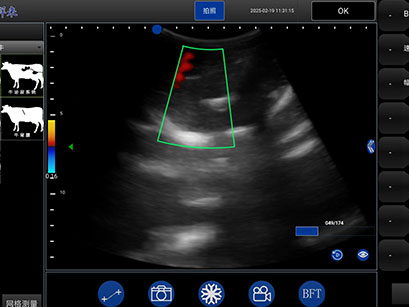Early pregnancy detection is crucial for efficient cattle management, enabling farmers and veterinarians to optimize breeding programs, reduce calving intervals, and enhance overall herd productivity. Identifying pregnancy as early as possible helps prevent unnecessary culling, improves reproductive performance, and ensures timely re-breeding for non-pregnant cows.

In this article, we explore the earliest pregnancy diagnosis tests for bovine, including their accuracy, advantages, and the best options available for modern cattle operations.
Earliest Bovine Pregnancy Diagnosis Methods
Several methods are available for early pregnancy detection in cows, each with varying degrees of accuracy and practicality. The most effective tests include ultrasound scanning, blood tests, and biochemical markers.
1. Ultrasound Examination (As Early as 25-30 Days Post-Breeding)
Ultrasound is the most reliable and widely used method for early bovine pregnancy detection.
How it Works:
A rectal ultrasound uses high-frequency sound waves to visualize the reproductive tract and detect an embryo in the uterus.
Veterinarians can assess fetal viability, determine gestational age, and detect twin pregnancies.
Advantages:
✔ Detects pregnancy as early as 25-30 days post-insemination.
✔ Provides real-time imaging of the fetus and reproductive structures.
✔ Allows monitoring of fetal heartbeat and uterine health.
Limitations:
Requires specialized equipment and veterinary expertise.
Costlier than manual palpation but offers greater accuracy.
2. Blood Pregnancy Tests (As Early as 28 Days Post-Breeding)
Blood-based pregnancy tests, such as the BioPRYN and DG29 tests, detect pregnancy-associated glycoproteins (PAGs) produced by the placenta.
How it Works:
A blood sample is collected from the cow and analyzed for PAG levels, which indicate pregnancy.
Advantages:
✔ Highly accurate (97%+ accuracy) when performed after 28 days post-breeding.
✔ Non-invasive and easy to conduct.
✔ Does not require rectal palpation or specialized imaging equipment.
Limitations:
Cannot determine fetal viability or twin pregnancies.
Results take 24-48 hours, depending on lab processing time.
3. Milk Pregnancy Tests (As Early as 28-30 Days Post-Breeding)
Milk-based pregnancy tests, such as the Idexx Milk Pregnancy Test, detect pregnancy-associated glycoproteins in milk samples.
Advantages:
✔ Non-invasive and stress-free for cows.
✔ Convenient for dairy farms using regular milk sampling.
✔ Similar accuracy to blood tests.
Limitations:
Only suitable for lactating cows.
Less commonly used in beef cattle operations.
4. Rectal Palpation (As Early as 35-40 Days Post-Breeding)
Manual rectal palpation is a traditional method for pregnancy detection in cows, performed by trained veterinarians or technicians.
How it Works:
The veterinarian palpates the uterus through the rectal wall to feel for pregnancy indicators such as an enlarged uterine horn or fetal membranes.
Advantages:
✔ Cost-effective and does not require special equipment.
✔ Commonly used in both dairy and beef operations.
Limitations:
Accuracy depends on the experience of the technician.
Risk of causing stress or accidental pregnancy loss if not performed correctly.
Cannot detect pregnancy as early as ultrasound or blood tests.
Which Test is Best for Early Pregnancy Detection?
For the earliest and most accurate pregnancy diagnosis in cattle, ultrasound scanning (25-30 days) and blood pregnancy tests (28 days) are the best options.
Ultrasound is ideal for large-scale operations needing real-time fetal assessment.
Blood tests are excellent for farms that prefer a simple, non-invasive method.
Milk tests provide a convenient alternative for dairy farms.
Rectal palpation is a cost-effective solution but not suitable for early detection.